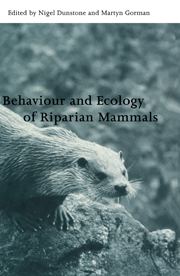Book contents
- Frontmatter
- Contents
- List of contributors
- Preface
- 1 Adaptations to the semi-aquatic habit and habitat
- 2 Physiological challenges in semi-aquatic mammals: swimming against the energetic tide
- 3 Diving capacity and foraging behaviour of the water shrew (Neomys fodiens)
- 4 Habitat use by water shrews, the smallest of amphibious mammals
- 5 The importance of the riparian environment as a habitat for British bats
- 6 A preliminary study of the behaviour of the European mink Mustela lutreola in Spain, by means of radiotracking
- 7 The demography of European otters Lutra lutra
- 8 Habitat use and conservation of otters (Lutra lutra) in Britain: a review
- 9 The relationship between riverbank habitat and prey availability and the distribution of otter (Lutra lutra) signs: an analysis using a geographical information system
- 10 Influence of altitude on the distribution, abundance and ecology of the otter (Lutra lutra)
- 11 Diets of semi-aquatic carnivores in northern Belarus, with implications for population changes
- 12 Otter (Lutra lutra) prey selection in relation to fish abundance and community structure in two different freshwater habitats
- 13 Diet, foraging behaviour and coexistence of African otters and the water mongoose
- 14 Feeding ecology of the smooth-coated otter Lutra perspicillata in the National Chambal Sanctuary, India
- 15 Population trends of hippopotami in the rivers of the Kruger National Park, South Africa
- 16 Reproductive strategies of female capybaras: dry-season gestation
- 17 The continuing decline of the European mink Mustela lutreola: evidence for the intraguild aggression hypothesis
- 18 Otters and pollution in Spain
- 19 The rapid impact of resident American mink on water voles: case studies in lowland England
- 20 Status, habitat use and conservation of giant otter in Peru
- Index
10 - Influence of altitude on the distribution, abundance and ecology of the otter (Lutra lutra)
Published online by Cambridge University Press: 03 May 2010
- Frontmatter
- Contents
- List of contributors
- Preface
- 1 Adaptations to the semi-aquatic habit and habitat
- 2 Physiological challenges in semi-aquatic mammals: swimming against the energetic tide
- 3 Diving capacity and foraging behaviour of the water shrew (Neomys fodiens)
- 4 Habitat use by water shrews, the smallest of amphibious mammals
- 5 The importance of the riparian environment as a habitat for British bats
- 6 A preliminary study of the behaviour of the European mink Mustela lutreola in Spain, by means of radiotracking
- 7 The demography of European otters Lutra lutra
- 8 Habitat use and conservation of otters (Lutra lutra) in Britain: a review
- 9 The relationship between riverbank habitat and prey availability and the distribution of otter (Lutra lutra) signs: an analysis using a geographical information system
- 10 Influence of altitude on the distribution, abundance and ecology of the otter (Lutra lutra)
- 11 Diets of semi-aquatic carnivores in northern Belarus, with implications for population changes
- 12 Otter (Lutra lutra) prey selection in relation to fish abundance and community structure in two different freshwater habitats
- 13 Diet, foraging behaviour and coexistence of African otters and the water mongoose
- 14 Feeding ecology of the smooth-coated otter Lutra perspicillata in the National Chambal Sanctuary, India
- 15 Population trends of hippopotami in the rivers of the Kruger National Park, South Africa
- 16 Reproductive strategies of female capybaras: dry-season gestation
- 17 The continuing decline of the European mink Mustela lutreola: evidence for the intraguild aggression hypothesis
- 18 Otters and pollution in Spain
- 19 The rapid impact of resident American mink on water voles: case studies in lowland England
- 20 Status, habitat use and conservation of giant otter in Peru
- Index
Summary
Introduction
The otter (Lutra lutra), a semi–aquatic mustelid, has suffered a significant population decline in Europe (Mason & Macdonold, 1986; Foster–Turley et al, 1990). There are several possible causes, although without doubt pollution, the destruction of habitat and the variation of available food have played an important part (Macdonald & Mason, 1992; Kruuk, 1995). The species is one of the most intensively studied of all European mammals, primarily because of its status as a bioindicator species at the top of many freshwater food chains. It has also become an emblem of many conservation projects throughout the world. All these studies have been carried out in coastal environments or in areas of relatively low altitude. This is because few European countries with populations of otters have any significant land that is higher than 1000 m above sea level (a.s.l.) (e.g. Norway, France, Slovakia, Slovenia, Croatia, Bosnia, Yugoslavia, Greece, Bulgaria, Rumania and Spain). In several, the otter has become extinct or scarce, and only two (Greece and Spain) have otter populations in large mountain ranges that exceed 2000 m a.s.l. This means that the effect of altitude, a significantly limiting factor for many species, has not been studied for otters.
Mason & Macdonald (1986) point out that L. lutra kutab has been observed at 4120 m in Tibet; others report that it is more abundant in low areas, with fewer tracks and signs with increasing altitude (Green & Green, 1980; Chapman & Chapman, 1982; Delibes, 1990).
- Type
- Chapter
- Information
- Behaviour and Ecology of Riparian Mammals , pp. 159 - 176Publisher: Cambridge University PressPrint publication year: 1998
- 12
- Cited by

